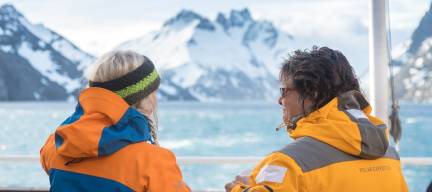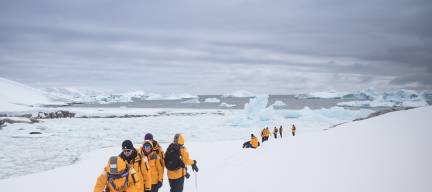For many travelers, the first glimpse of a towering iceberg feels surreal. Its sheer size, intricate shapes, and ever-changing shades of blue make it one of nature’s most photogenic subjects. On Antarctic expeditions, guests often find themselves overwhelmed by the visual possibilities—where to stand, how to capture reflections, and how to tell a story through a single frame. Photographing icebergs isn’t just about snapping a shot; it’s about creating images that convey the drama and serenity of the polar world.
Expedition guides and photographers with years of polar experience often share practical tips to help guests make the most of their time in the field. Whether you’re a casual traveler with a smartphone or an experienced photographer with a full kit, the principles remain the same: focus on light, angles, reflections, and patience. For travelers seeking structured journeys designed for immersive photography, the Antarctic Express: Crossing the Circle is a great choice, pairing adventure with expert-led guidance. You can also explore a wide variety of Antarctic travel options tailored to active explorers and photographers alike.

Light is Everything
In polar environments, light changes rapidly, and it can transform the mood of your image within minutes. Early morning and late evening often bring softer, warmer tones that add depth to the cold blues of the ice. Overcast skies, meanwhile, reduce glare and highlight subtle textures on the iceberg’s surface. Expedition experts recommend adjusting your exposure to prevent highlights from washing out—especially when strong sunlight reflects off the ice.
Look for Reflections
Calm waters often provide mirror-like surfaces that double the impact of your composition. Position yourself low to the water when possible—Zodiac rides during polar trips are perfect for this. A reflected iceberg creates symmetry and balance in a frame, and sometimes, the reflection reveals colors and shapes that the naked eye misses. Including these elements not only makes for striking images but also enhances the storytelling element of polar photography.
Use Scale to Tell a Story
One of the biggest challenges in photographing icebergs is conveying their size. Without a reference point, viewers can’t appreciate just how massive these floating sculptures can be. Include a Zodiac, seabird, or even distant travelers in your shot to give your audience a sense of scale. Expedition photographers often emphasize that storytelling through images isn’t just about the iceberg itself—it’s about placing the subject in a relatable context.

Be Patient and Observe
Icebergs are constantly shifting. Sunlight changes angles, clouds pass overhead, and wildlife sometimes enters the frame. Seals may rest on floes or penguins may dive nearby, adding an extra dimension to your composition. For those passionate about wildlife photography, patience is as important as technical skill. By waiting just a few moments longer, you might capture a penguin leaping into the water with a gleaming wall of ice behind it—an image that resonates more deeply than a standard landscape shot.
Experiment with Angles and Equipment
Don’t be afraid to change perspectives. Shooting from water level offers dramatic reflections, while higher viewpoints—like a ship’s deck—can capture patterns of cracks and crevices. Wide-angle lenses are useful for showcasing massive icebergs against the horizon, while telephoto lenses help isolate details like sculpted arches or crystal-clear textures. Even smartphones can capture excellent images when used creatively. Remember, the most memorable shots often come from experimenting with angles others overlook.
Storytelling Through Sequences
Experts encourage travelers to think beyond single shots. A sequence of images can tell a fuller story: the approach to the iceberg, the close-up of intricate textures, and the wider scene with wildlife in the background. Such collections give viewers a sense of presence, almost as though they are traveling alongside you on an Antarctic Circle cruise.
Respect the Environment
Perhaps the most important tip from expedition leaders is to always respect the polar environment. Follow guidance from your crew, maintain safe distances from wildlife, and avoid disturbing natural formations. Great photography should coexist with responsible exploration.
For those eager to apply these techniques on their journey, the Antarctic Explorer: Discovering the 7th Continent is an ideal choice. Guests not only have the opportunity to photograph breathtaking icebergs but also gain insights from seasoned guides. To explore more journeys across both poles, visit Quark Expeditions, a leader in polar travel for over 30 years.

Final Thoughts
Photographing icebergs is more than just capturing beauty—it’s about preserving moments that embody the wonder of the polar regions. From subtle light shifts to surprising wildlife encounters, every photo can become a personal story of discovery. By following tips from expedition experts, travelers can transform fleeting glances into timeless images. Whether it’s reflections on still waters or the vastness of an iceberg dwarfing a small boat, each frame becomes a reminder of the rare privilege of exploring Earth’s last great frontiers.









